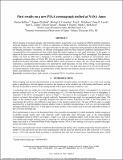| dc.contributor.author | Belikov, R. | |
| dc.contributor.author | Pluzhnik, E. | |
| dc.contributor.author | Connelley, M. S. | |
| dc.contributor.author | Witteborn, F. C. | |
| dc.contributor.author | Lynch, D. H. | |
| dc.contributor.author | Cahoy, K. L. | |
| dc.contributor.author | Guyon, O. | |
| dc.contributor.author | Greene, T. P. | |
| dc.contributor.author | McKelvey, M. E. | |
| dc.date.accessioned | 2017-08-01T20:07:23Z | |
| dc.date.available | 2017-08-01T20:07:23Z | |
| dc.date.issued | 2009-01-01 | |
| dc.identifier.issn | 0277-786X | |
| dc.identifier.uri | http://hdl.handle.net/1721.1/110899 | |
| dc.description.abstract | Direct imaging of extrasolar planets, and Earth-like planets in particular, is an exciting but difficult problem requiring a telescope imaging system with 1010 contrast at separations of 100 mas and less. Furthermore, the current NASA science budget may only allow for a small 1-2 m space telescope for this task, which puts strong demands on the performance of the imaging instrument. Fortunately, an efficient coronagraph called the Phase Induced Amplitude Apodization (PIAA) coronagraph has been maturing and may enable Earth-like planet imaging for such small telescopes. In this paper, we report on the latest results from a new testbed at NASA Ames focused on testing the PIAA coronagraph. This laboratory facility was built in 2008 and is designed to be flexible, operated in a highly stabilized air environment, and to complement existing efforts at NASA JPL. For our wavefront control we are focusing on using small Micro-Electro- Mechanical-System deformable mirrors (MEMS DMs), which promises to reduce the size of the beam and overall instrument, a consideration that becomes very important for small telescopes. At time of this writing, we are operating a refractive PIAA system and have achieved contrasts of about 1.2×10-7 in a dark zone from 2.0 to 4.8 λ/D (with 6.6×10-8 in selected regions). In this paper, we present these results, describe our methods, present an analysis of current limiting factors, and solutions to overcome them. | en_US |
| dc.publisher | SPIE - The International Society for Optical Engineering | en_US |
| dc.subject | Phase Induced Amplitude Apodization | en_US |
| dc.subject | PIAA coronagraph | en_US |
| dc.subject | NASA | en_US |
| dc.subject | Ames coronograph | en_US |
| dc.subject | Earth-like planets | en_US |
| dc.subject | extrasolar planets | en_US |
| dc.subject | telescope imaging system | en_US |
| dc.subject | Micro-Electro-Mechanical-System deformable mirrors | en_US |
| dc.subject | aspheric optics | en_US |
| dc.subject | Fourier Transform | en_US |
| dc.title | First results on a new PIAA coronagraph testbed at NASA Ames | en_US |
| dc.type | Presentation | en_US |
| dc.identifier.citation | Belikov, R., Pluzhnik, E., Connelley, M., Witteborn, F., Lynch, D., Cahoy, K., & ... McKelvey, M. (2009). First results on a new PIAA coronagraph testbed at NASA Ames. Proceedings Of The SPIE - The International Society For Optical Engineering, 7440(12 pp.). doi:10.1117/12.826772 | en_US |
| dc.contributor.department | Space Telecommunications Astronomy and Radiation (STAR) Lab | |
| dc.contributor.department | Massachusetts Institute of Technology. Department of Aeronautics and Astronautics | |
